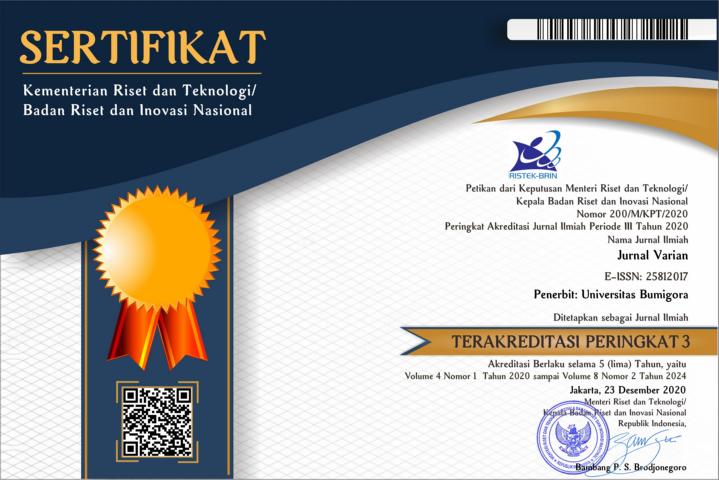The NADI Mathematical Model on the Danger Level of the Bili-Bili Dam
Abstract
The research discusses the NADI mathematical model due to the overflow of the Bili-Bili dam, using secondary data obtained through online literature review by collecting various information related to the Bili-Bili Dam, starting from the Jeberang River Scheme, the chronology of floods, normal or dry conditions, and dam operation patterns. The aim of this study is to predict the level of danger of Bili-bili dam overflow over time, considering extreme weather factors and standard operating procedures performed by humans. The research uses analytical and computational methods. The study obtained the NADI mathematical model due to the overflow of the Bili-Bili dam, with two equilibrium points: (1) the equilibrium point free of disaster, (2) the disaster equilibrium point, and a basic disaster reproduction number of R0 = 1.219. This indicates that the water discharge from the dam is high and has an impact on the overflowing water for communities around the Jeneberang river. Therefore, it can be concluded that the NADI model can be used to simulate the Bili-bili dam process based on extreme weather and dam SOP, and predict the level of danger of Bili-bili dam overflow, which is also a novelty that has not been done in previous studies.
References
Annas, S., Pratama, M. I., Rifandi, M., Sanusi, W., & Side, S. (2020). Stability Analysis and Numerical Simulation of SEIR Model for Pandemic COVID-19 Spread in Indonesia. Chaos, Solitons and Fractals, 139. https://doi.org/10.1016/j.chaos.2020.110072
Asri, M., Sidjara, S., Sanusi, W., Side, S., & Pratama, M. I. (2021). Analysis and Solution of The SEIRS Model for The Rubella Transmission with Vaccination Effect using Runge-Kutta Method. Journal of Physics: Conference Series, 1899(1), 12090. https://doi.org/10.1088/1742-6596/1899/1/012090
Darmawan, K., Suprayogi, A. (2017). Analisis Tingkat Kerawanan Banjir di Kabupaten Sampang Menggunakan Metode Overlay dengan Scoring Berbasis Sistem Informasi Geografis. Jurnal Geodesi Undip, 6(1), 31–40. https://ejournal3.undip.ac.id/index.php/geodesi/article/view/15024
Djalante, R., Lassa, J., Setiamarga, D., Sudjatma, A., Indrawan, M., Haryanto, B., Mahfud, C., Sinapoy, M. S., Djalante, S., Rafliana, I., Gunawan, L. A., Surtiari, G. A. K., & Warsilah, H. (2020). Review and analysis of current responses to COVID-19 in Indonesia: Period of January to March 2020. Progress in Disaster Science, 6, 100091. https://doi.org/10.1016/j.pdisas.2020.100091
Maryam, H., Abdy, M., Alimuddin, & Side, S. (2021). SEIAS-SEI model on asymptomatic and super infection malaria with imperfect vaccination. Journal of Physics: Conference Series, 1918(4), 42028. https://doi.org/10.1088/1742-6596/1918/4/042028
Niode, D. F., Rindengan, Y. D. Y., & Karouw, S. D. S. (2016). Geographical Information System (GIS) untuk Mitigasi Bencana Alam Banjir Kota Manado. E-Journal Teknik Elektro Dan Komputer, 5(2).
Nurhaeda, Anas, S., & Side, S. (2021). Analysis and simulation of mathematical model for typhus disease in Makassar. Journal of Physics: Conference Series, 1918(4), 42025. https://doi.org/10.1088/1742-6596/1918/4/042025
Risman, Warsiti, Mawardi, Martono, & Satriyadi, L. (2016). Kajian Perilaku Aliran melalui Alat Ukur Debit Mercu Bulat Terhadap Tinggi Muka Air. Bangun Rekaprima: Majalah Ilmiah Pengembangan Rekayasa, Sosial, Dan Humaniora, 2(1), 20–32.
Shereen, M. A., Khan, S., Kazmi, A., Bashir, N., & Siddique, R. (2020). COVID-19 infection: Origin, transmission, and characteristics of human coronaviruses. Journal of Advanced Research, 24, 91–98. https://doi.org/10.1016/j.jare.2020.03.005
Side, S., Utami, A. M., Sukarna, & Pratama, M. I. (2018). Numerical solution of SIR model for transmission of tuberculosis by Runge-Kutta method. Journal of Physics: Conference Series, 1–8. https://doi.org/10.1088/1742-6596/1040/1/012021
Side, Syafruddin, Alimuddin, & Bani, A. (2018). Modifikasi Model SIR pada Penyebaran Penyakit Demam Berdarah Dengue di Kabupaten Bone. 1(2), 169–182.
Side, Syafruddin, Azizah Muzakir, N., Pebriani, D., & Utari, S. N. (2020). Model SEIR Kecanduan Game Online pada Siswa di SMP Negeri 3 Makassar SEIR Model of Online Game Addiction on Students in Junior High School 3 Makassar. Jurnal Sainsmat, IX(1), 91–102. http://ojs.unm.ac.id/index.php/sainsmat
Side, Syafruddin, Sukarna, S., Asfarina, G. T., Isbar Pratama, M., & Mulbar, U. (2018). Analysis of SEIRS Model for Cholera Spreading with Vaccination and Treatment Factors. Journal of Physics: Conference Series. https://doi.org/10.1088/1742-6596/1114/1/012120
Sohrabi, C., Alsafi, Z., O’Neill, N., Khan, M., Kerwan, A., Al-Jabir, A., Iosifidis, C., & Agha, R. (2020). World Health Organization declares global emergency: A review of the 2019 novel coronavirus (COVID-19). In International Journal of Surgery. https://doi.org/10.1016/j.ijsu.2020.02.034
Suwaryo, P. A. W., & Yuwono, P. (2017). Faktor-faktor yang mempengaruhi tingkat pengetahuan masyarakat dalam mitigasi bencana alam tanah longsor. Urecol 6th, University Research Colloquium 2017, 305–314. http://journal.unimma.ac.id/index.php/urecol/article/view/1549

This work is licensed under a Creative Commons Attribution 4.0 International License.


















